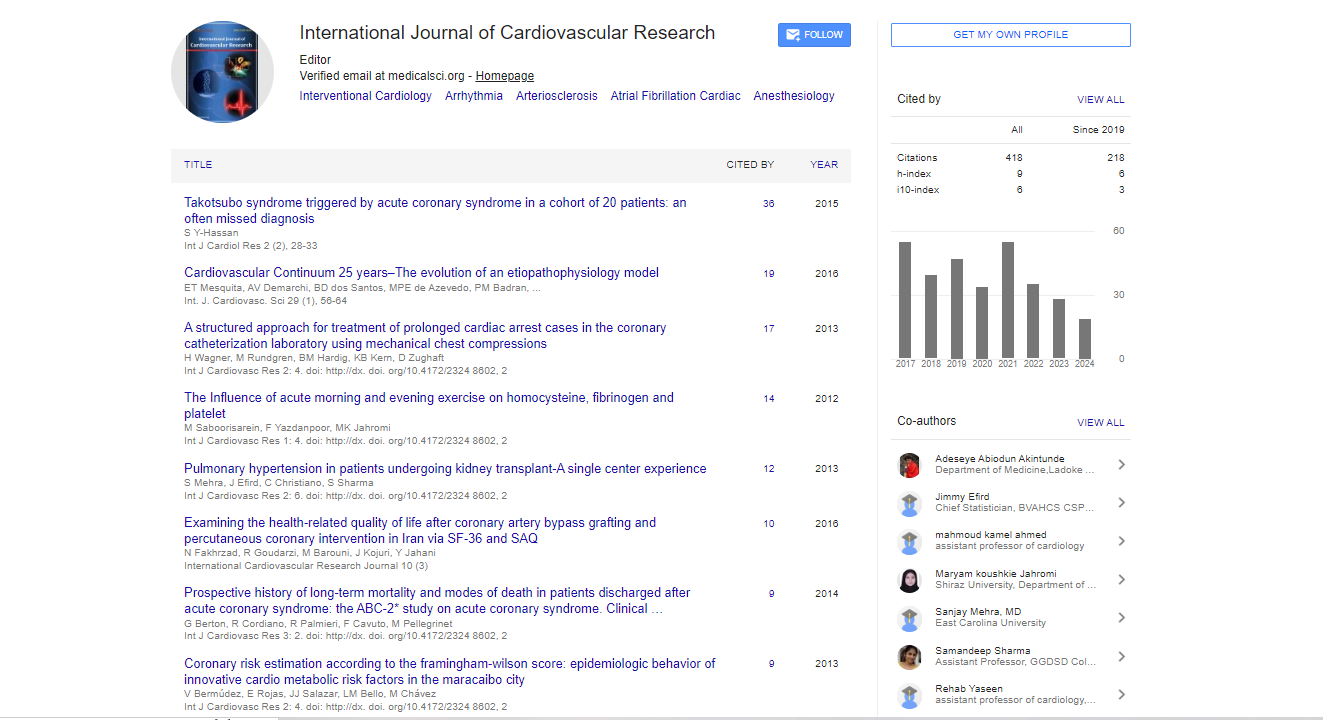Opinion Article, Int J Cardiol Res Vol: 13 Issue: 3
Artificial Hearts and the Future of Cardiac Therapeutics
Xui Li*
1Department of Vascular Surgery, Soochow University, Suzhou, China
*Corresponding Author: Xui Li,
Department of Vascular Surgery, Soochow
University, Suzhou, China
E-mail: xli@126.com
Received date: 27 May, 2024, Manuscript No. ICRJ-24-144343;
Editor assigned date: 30 May, 2024, PreQC No. ICRJ-24-144343 (PQ);
Reviewed date: 13 June, 2024, QC No. ICRJ-24-144343;
Revised date: 21 June, 2024, Manuscript No. ICRJ-24-144343 (R);
Published date: 28 June, 2024, DOI: 10.4172/2324-8602.1000562
Citation: Li X (2024) Artificial Hearts and the Future of Cardiac Therapeutics. Int J Cardiol Res 13:3.
Description
The artificial heart, an innovative device designed to replicate the functions of a biological heart, represents a novel advancement in the field of cardiovascular medicine. This technology offers an essential connection for patients with end stage heart failure .The development and evolution of artificial hearts reflect significant progress in biomedical engineering and have the potential to transform cardiac care. Artificial hearts are broadly categorized into Total Artificial Hearts (TAHs) and Ventricular Assist Devices (VADs). Each type serves distinct purposes and operates based on different design principles. TAHs are designed to replace the entire heart and are used in patients with severe, end stage heart failure a heart transplant. The TAH consists of a pair of ventricles that are responsible for pumping blood throughout the body and the lungs. The device is typically powered by an external console that supplies compressed air to drive the mechanical pumps.
VADs on the other hand, are designed to support the function of one or both ventricles rather than replace the entire heart. There are several types of VADs, including Left Ventricular Assist Devices (LVADs), Right Ventricular Assist Devices (RVADs) and Biventricular Assist Devices (BiVADs). LVADs are the most commonly used and assist the left ventricle in pumping blood to the systemic circulation. The design principles of artificial hearts involve replicating the physiological functions of the natural heart. Key considerations include mimicking the heart's pulsatile flow, maintaining appropriate hemodynamics and ensuring biocompatibility to minimize the risk of adverse reactions. The materials used in artificial hearts must be durable and resistant to wear while also being compatible with the body's tissues to prevent clot formation and infection.
Clinical applications and benefits
Artificial hearts have revolutionized the management of end-stage heart failure, offering patients an alternative when standard treatments have failed. For patients awaiting heart transplantation, artificial hearts can serve as a temporary solution, providing essential support while a suitable donor heart is identified. This application has significantly improved the survival rates of patients on the transplant list. In cases where heart transplantation is not feasible, artificial hearts can be used as a long-term solution to manage advanced heart failure. Long-term management with artificial hearts has been shown to improve quality of life and extend survival in selected patients. In some instances, artificial hearts can be used to support patients' recovery from acute heart failure or myocardial infarction, allowing the damaged heart muscle time to heal and regain function. The benefits of artificial hearts are significant. They provide an important support for patients with severe heart failure, enabling them to lead more active lives and experience an improved quality of life. Additionally, artificial hearts have the potential to reduce hospitalizations and medical costs associated with heart failure management.
Despite their remarkable advancements, artificial hearts face several challenges and limitations. The mechanical components of artificial hearts are affected by usage which can lead to device malfunction or failure. Ensuring the long term durability of these devices is an essential challenge for engineers and manufacturers. Patients with artificial hearts are at risk of complications such as infection, bleeding and thrombosis. The risk of stroke and other thromboembolic events remains a concern, necessitating careful management and anticoagulation therapy. While artificial hearts can improve survival, they may also impact patient’s quality of life. The need for external power sources, frequent medical visits and the potential for devicerelated complications can affect patients overall well-being. The cost of artificial hearts and their associated care can be excessively high, limiting their accessibility to certain patient populations. Addressing the cost and ensuring equitable access to this technology are ongoing challenges.
Future prospects and innovations
The future of artificial hearts provides possibilities for further advancements and innovations. Efforts are to develop hybrid devices that combine mechanical and biological components, such as tissueengineered constructs or biologically active surfaces. These advancements aim to improve the integration of artificial hearts with the body's natural tissues and reduce the risk of complications. Advances in personalized medicine and patient-specific modeling may enable the development of artificial hearts personalized to individual patients' anatomical and physiological needs. This approach could enhance the effectiveness and safety of artificial heart therapy. The field of regenerative medicine provides advancements in heart replacement technologies. Stem cell therapies, tissue engineering and gene editing may contribute to the creation of biologically based heart replacements and offer new possibilities for treating heart failure.
Conclusion
Artificial hearts represent a significant event in the field of cardiovascular medicine, providing essential support for patients with end stage heart failure. The evolution of artificial heart technology has transformed cardiac care, offering new opportunities for survival and improved quality of life. Despite the challenges and limitations, ongoing study and innovation provides further advancements.
 Spanish
Spanish  Chinese
Chinese  Russian
Russian  German
German  French
French  Japanese
Japanese  Portuguese
Portuguese  Hindi
Hindi 



